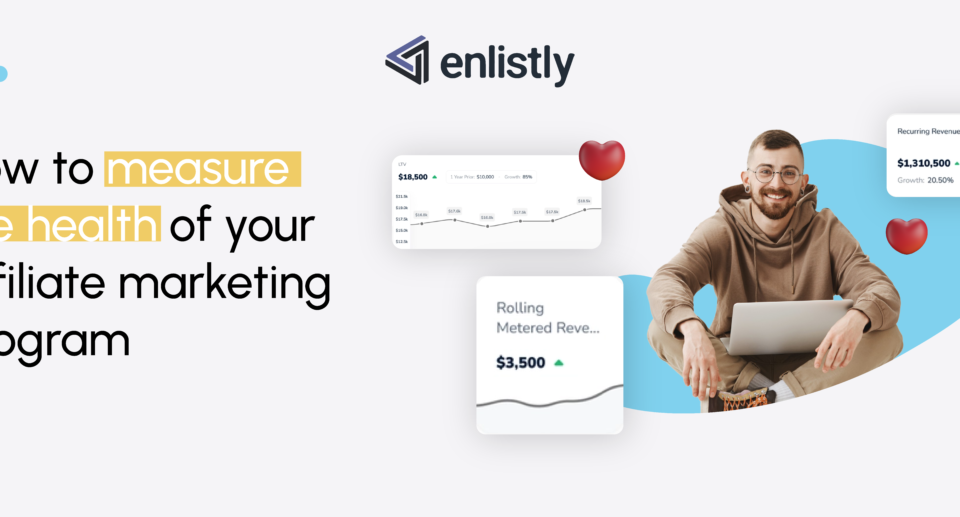Ecommerce Affiliate Marketing Metrics – How To Measure The Success Of Your Affiliate Marketing Program

List of all the ecommerce affiliate marketing metrics you should measure.
No affiliate marketing program is created equal. While there are some industry standards, many factors go into the success (or failure) of a campaign.
Although affiliate marketing is considered a form of word-of-mouth marketing, you need to still pay attention to the metrics that tell the story of your affiliate marketing campaign.
If you are running an affiliate program for your e-commerce business, you probably have a hard time deciding which metrics to look at and how to find the insights they offer. Luckily, we’ve created just the thing to help you – the most important eCommerce affiliate marketing metrics you should be tracking.
14 eCommerce affiliate marketing metrics your online business must look into
1. Clicks
Clicks are the number of times people click on your ads.
This is a pretty basic metric, but it’s important to understand what it means. The more clicks you have, the more people are seeing your ads—and if they’re clicking on your ads, it means they’re at least somewhat interested in what you’re offering.
But that doesn’t mean they’re going to buy anything! It just means they’re at least curious enough to click through and learn more about what you’re selling. So this metric isn’t a perfect indicator of sales success; it’s just an indicator that some people are interested enough in what you’re selling to click on it.
The more clicks, the better!
2. Signups
Signups are the number of leads your website generates.
If a visitor enters their email address to receive your newsletter, they’re a signup. If they click on a link to download an ebook, they’re a signup. A lead is someone who has expressed interest in what you have to offer; it could be a signup or it could be someone who called your business directly, but if they did so because of something they saw on your website, that’s still considered a lead.
Signups are a key metric for affiliate marketing because they represent the number of people who have shown some interest in your product.
While signups don’t always translate into sales, they do provide valuable insight into the effectiveness of your marketing efforts.
When you’re tracking signups, you should be looking at the number of new users who have signed up for your service in a given month (or quarter). If this number is growing steadily, then you can feel confident that your business is going well.
3. Number of sales actions
The number of sales actions is an important metric to measure the success of your affiliate marketing program.
This metric is a good indicator of the number of people who are visiting your website and clicking through to make a purchase. You can also use this metric to see how many people are coming back to your site and making multiple purchases.
The number of sales actions should be measured over the course of several weeks or months in order to get an accurate picture of how well your affiliate program is performing.
You can also use this metric to see what types of sales tactics are most effective for your business. If people are clicking on one type of link more than others, it might be worth investing in that particular product or service.
4. Conversion rate
The conversion rate is the number of people who buy a product divided by the number of people who visit a product page.
The conversion rate shows the effectiveness of individual affiliates, which is an important metric to track and measure. It represents the percentage of visitors who clicked on an affiliate’s link on a website and then converted it into customers.
It’s calculated by dividing the number of sales generated by an affiliate by the number of clicks on their links.
This metric is important because it helps you determine whether or not an affiliate is performing well, and if they aren’t, it can help you identify which ads are producing results and which ones are not. This in turn helps you decide who to work with and how much to pay them.
5. Return on ad spend (ROAS)
Advertising is one of the most important ways to get your e-commerce business in front of prospective customers. But how do you know if it’s working? How can you make sure that all the money you’re spending on ads is producing the best ROAS?
Return on ad spend is a metric that measures how much revenue an ad generates for every dollar spent. If you have a high ROAS, then your ads are generating more money than what it costs to run them.
6. Recurring revenue
Recurring revenue is the holy grail of e-commerce companies. It means that your customers are buying from you again, regularly.
It’s important because it shows that your customers are happy with your products and that they’re willing to continue buying from you, instead of just once.
7. New customers
To measure your e-commerce business’s performance, you need to know how many new customers you’ve added.
This metric is important because it tells you how effective your marketing strategy is at bringing in new customers. For example, if you’re running a paid ad campaign and see that you’re acquiring new customers at a rate of 1% every month, then your campaign needs work—you should be able to increase that number by putting more resources into the campaign or adjusting its parameters.
8. Incremental revenue
Incremental revenue is a great metric to look at if you’re trying to determine whether or not your affiliate program is paying off. If incremental revenue goes up, it means that your affiliates are generating more sales for you than they would have without the program.
Incremental revenue is the amount of money that you make over and above your baseline sales. It’s important to track incremental revenue because it helps you determine how well your affiliate marketing efforts are working—you can compare it to your previous months’ sales to see if they’re increasing, or you can use it as a basis for comparison when you introduce new affiliate programs.
The formula for incremental revenue is as follows:
Total Revenue – Baseline Sales = Incremental Revenue
In other words, if you made $100 in total revenue last month, and this month you made $120 in total revenue, then your incremental revenue is $20.
9. Cost per click and cost per sale
These metrics give you an idea of how much it’s costing you to get clicks and how much each sale is costing. By tracking these metrics, you can figure out which campaigns are working best for you, and what kinds of keywords or links are bringing in the most traffic.
The cost per click is the amount you spend to advertise on a given platform. It’s the total amount divided by the number of clicks you receive. For example, if it costs $10,000 to advertise on Facebook and you receive 20,000 clicks, your cost per click would be 50 cents.
The cost per sale is the amount it costs for each product sold through your advertisement. This can vary depending on what type of product or service you’re selling—if it’s expensive, then this number will likely be higher than if it’s cheap.
10. Percent of active affiliates
This is the percentage of affiliates that are actually making sales, as opposed to just signing up and never doing anything else.
As the owner of an affiliate program, you might be proud of the number of affiliates you have in your program—but how many are actually active?
It’s important to know because affiliates that aren’t sending any traffic or making any sales are essentially useless. They’re costing you money without providing any benefit. So, it’s important to make sure that you’re only paying out commissions to affiliates who are actively sending traffic and making sales.
11. Type of active affiliates
You can segment your affiliates based on the type of traffic they send, as well as their performance.
12. Number of lapsed affiliates
Lapsed affiliates are those who no longer promote your products, but still have their affiliate links posted online. They may have stopped promoting for any number of reasons, including a change in circumstances that made them unable to continue promoting (e.g., they lost their job or moved away), or because they simply decided to stop promoting after getting enough sales through your links.
It’s important to keep an eye on this metric because it tells you whether or not your affiliate program is working well enough to keep people engaged.
13. The number of top affiliates and their share of total sales
This metric will tell you how many affiliates are responsible for the majority of your sales, and how much those affiliates are contributing to your bottom line.
This will tell you how well your program is performing and whether you need to reward your top affiliates more to encourage them to continue promoting your brand.
At the end of the day, you’re only as good as the partners you keep. This is why it’s so important to track your most successful affiliates and see what they’re doing right—so that you can replicate it!
14. Reversed sales rate or chargeback rate
This metric measures the number of customers who buy your products, but then return them for a refund. It’s a good way to see how your customers feel about their experience with your eCommerce store.
If this number is too high, it could indicate that you have poor customer service. You may also want to look at what types of products are being returned and consider offering refunds on those items.
The higher this number is, the lower your business’s credibility will be.
Set up your affiliate program with Enlistly
As you can see, the key to affiliate marketing is monitoring a variety of metrics – and there’s no one-size-fits-all solution. It all depends on your business, your goals and objectives, as well as your brand, products, and audience. You’ll need to keep measuring and tweaking things as your business grows, but this will help you prioritize what matters most.
Nevertheless, tracking the right metrics will help you identify opportunities, weaknesses, and what you need to do
That is why we built a powerful analytics and tracking dashboard at Enlistly.
Set up your affiliate program with Enlistly and measure the success more effectively today!





